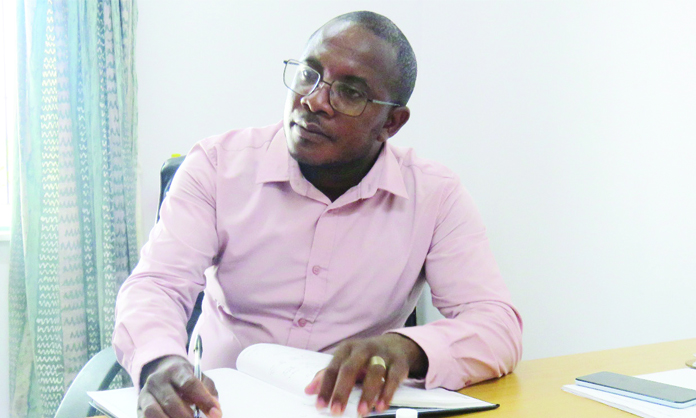The Kavango East region has marked major successes in reducing maternal death cases from 13 in 2019 to three in 2023, as well as implementing immunisation programmes in children, reaching 100% coverage in 2022.
This was said by chief health programme officer Peter Haita when he presented an overview of the region’s health profile, on behalf of the regional health management team, to Japanese ambassador to Namibia Nishimaki Hisao and United Nations Children’s Fund (Unicef) representative Samuel Ocran.
Haita attributed this success to support given by Unicef and the government of Japan.
According to regional health director Idah Mendai, who directed the programme, Namibia’s national expanded immunisation programme is an integral part of the primary healthcare which is administered at four levels – national, regional, district and health facilities.
Kavango East has three health districts with 31 health facilities and 28 health centres and clinics, two district and one Rundu Intermediate Hospital, all of which benefited from support from the Japanese government of N$32 million to strengthen support for cold chain management in response to the Covid-19 pandemic during 2021-2023.
The assistance from the Japanese government through Unicef helped the health ministry to strengthen the healthcare system’s response to the expanded immunisation programme by supporting the procurement of ultra-cold chain equipment, walk-in cold rooms, refrigerators, vaccine carriers, fridge tags and temperature monitors, to ensure vaccines are safely carried from one level of care to the next.
One walk-in storage facility was installed at Andara Catholic hospital in the region, with a patient catchment area of 62 500 people.
Haita said the trend of HIV testing for HIV exposed infants in the Kavango East had risen from 81% in 2019 to 96% in 2023 for babies aged six to eight weeks.
“This is because some of these babies are still at the hospital, or are presented to health workers for other programmes like immunisation,” he told the audience, which included United Nations resident coordinator in Namibia Hopolang Phororo.
In addition, Haita said testing for exposed babies at nine months had also risen from 33% in 2019 to 56% in 2023, while testing for babies aged up to 18 months had risen from 7% in 2019 to 30% in 2023.
“We can see the availability of information through health teams is bearing fruit as community members are being empowered to make informed decisions, hence more infants are being tested,” he said.
Commenting on the situation, Ocran said the country is approaching HIV epidemic control, but women continue to have a higher HIV prevalence (15,1%) than men (8,4%).
“Namibia has [achieved] tremendous success in the prevention of mother-to-child transmission of HIV – with a universal coverage of over 95%, including those for first ante-natal care testing and maternal antiretroviral therapy coverage,” he said.
However, there is a need for redoubled focus by strengthening our follow up and retention in care of pregnant and breastfeeding women, their infants and partners, to reduce the likelihood of vertical transmission through breastfeeding, he said.
“We are working closely with USAID on the HIV programme, more specifically mother-to-child transmission of HIV,” Ocran said.
According to Haita, the region had experienced a rise in the number of children under five years who had been admitted to hospital due to malnutrition and those who died from the condition.
“The rise in malnutrition can be attributed to the drought, which has resulted in food insecurity in communities,” he said.
Turning to causes of under-five morbidity and mortality in the region, Haita said 20 453 cases of diarrhoea without blood had been presented to health centres with respiratory disorders, accounting for 13 768 cases; skin disorders – 6 599; other diagnosis had 5 667 cases and gastro intestinal disorders accounted for 4 094 cases reported.
“Mortalities from unspecified severe protein malnutrition were 68, while pneumonia accounted for 50 deaths; bacterial sepsis of newborns had 31; gastroenteritis 24 and anaemia 22,” he said.
Among the achievements that Haita listed were that a total of 38 healthcare workers were trained in effective vaccine management; 32 were trained in immunisation in practice and 37 nurses and doctors were trained in emergency obstetrics and neo-natal care.
Highlighting the challenges, Haita said the region needs mobile clinics to strengthen and expand the geographic reach and regularity of outreach programmes. The outreach programme needs to be complemented by a well-equipped and well-trained cadre of community health workers.
Hisao expressed satisfaction with the way the Japanese assistance had been put to use in Namibia.
“I am happy with what I have seen, and Japan will continue with its financial and technical support to Namibia,” he said.
– email: matthew@namibian.com.na.
Stay informed with The Namibian – your source for credible journalism. Get in-depth reporting and opinions for
only N$85 a month. Invest in journalism, invest in democracy –
Subscribe Now!






